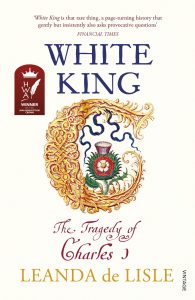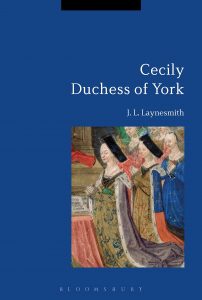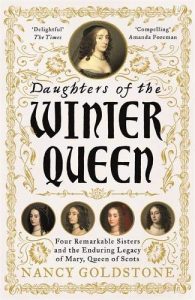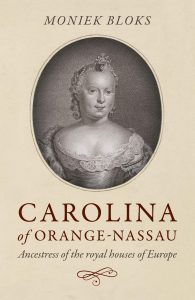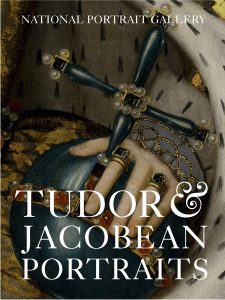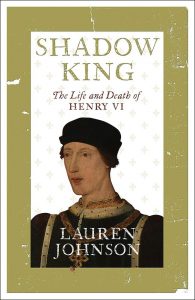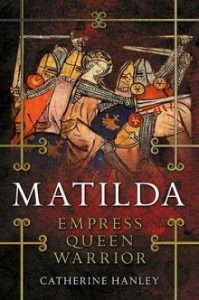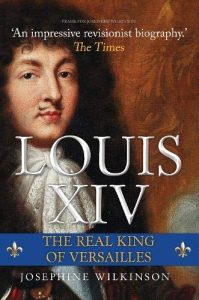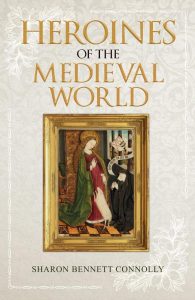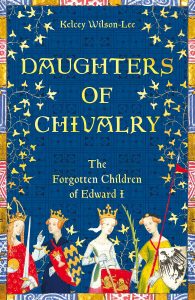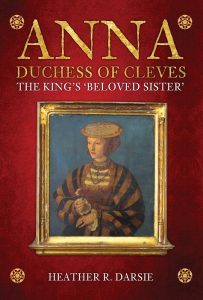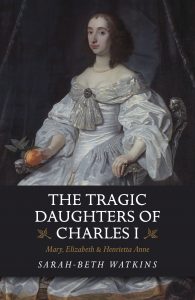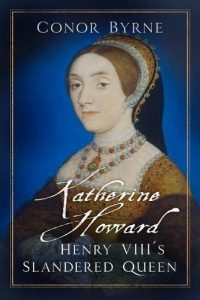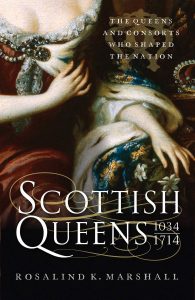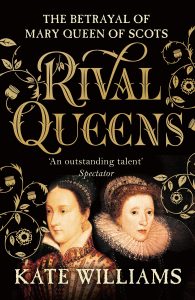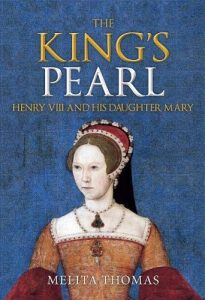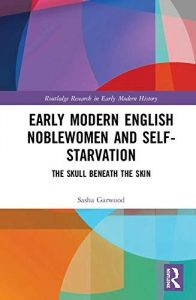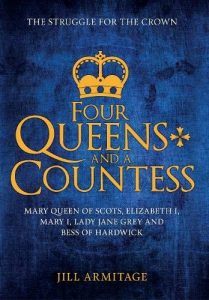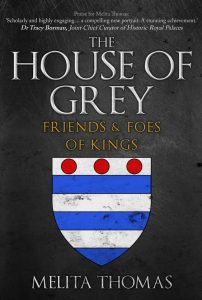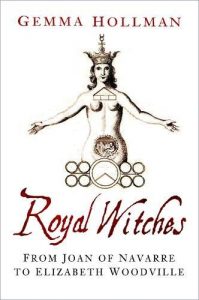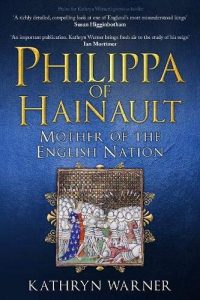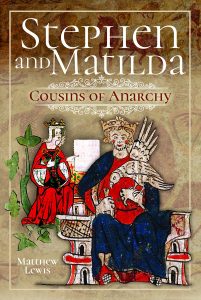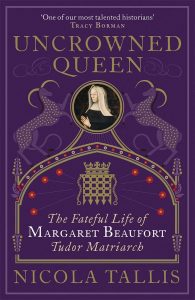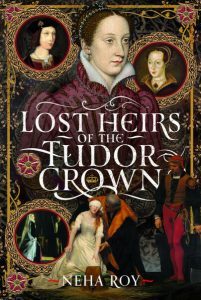10th January 2019 – White King: The Tragedy of Charles I (paperback) by Leanda de Lisle
‘Less than forty years after the golden age of Elizabeth I, England was at war with itself. At the head of this disintegrating kingdom was Charles I, who would change the face of the monarchy for ever.
His reign is one of the most dramatic in history, yet Charles the man remains elusive. To his enemies he was the ‘white tyrant of prophecy: to his supporters a murdered innocent. Today many myths still remain.
It is an epic story of glamour and strong women, of populist politicians and religious terror, of mass movements and a revolutionary new media: one that speaks to our own divided and dangerous times.’
Further details – Leanda de Lisle
24th January 2019 – Cecily Duchess of York (paperback) by J.L. Laynesmith
‘This is the first scholarly biography of Cecily Neville, duchess of York, the mother of Edward IV and Richard III. She was said to have ruled Edward IV ‘as she pleased’ and Richard III made his bid for the throne from her home. Yet Cecily has been a shadowy figure in modern histories, noted primarily for her ostentatious piety, her expensive dresses, and the rumours of her adultery. Here J. L. Laynesmith draws on a wealth of rarely considered sources to construct a fresh and revealing portrait of a remarkable woman. Cecily was the only major protagonist to live right through the Wars of the Roses. This book sheds new light on that bloody conflict in which Cecily proved herself an exceptional political survivor. Skilfully manipulating her family connections and contemporary ideas about womanhood, Cecily repeatedly reinvented herself to protect her own status and to ensure the security of those in her care. From her childhood marriage to Richard duke of York until her final decade as grandmother of the first Tudor queen, the story of Cecily Neville’s life provides a rich insight into national and local politics, women’s power and relationships, motherhood, household dynamics and the role of religion in fifteenth-century England.’
Further details – Amazon.co.uk
24th January – Daughters of the Winter Queen: Four Remarkable Sisters, the Crown of Bohemia and the Enduring Legacy of Mary, Queen of Scots (paperback) by Nancy Goldstone
‘Valentine’s Day, 1613. Elizabeth Stuart, the sixteen-year-old granddaughter of Mary, Queen of Scots, marries Frederick V, a German count and ally of her father, James I of England. In just five years a terrible betrayal will ruin ‘the Winter Queen’, as Elizabeth will forever be known, imperil the lives of those she loves and launch a war that lasts thirty years.
In a sweeping narrative encompassing political intrigue, illicit love affairs and even a murder mystery, Nancy Goldstone tells the riveting story of a queen in exile, and of her four defiant daughters.’
Further details – Nancy Goldstone
Further details – Amazon.co.uk
25th January – Carolina of Orange-Nassau: Ancestress of the royal houses of Europe by Moniek Bloks
‘Carolina of Orange-Nassau (1743 1787) was born the daughter of William IV, Prince of Orange, and Anne, Princess Royal and was thus the granddaughter of King George II. It was upon the King’s orders that she was named after his wife, Caroline of Ansbach. She was the first of Anne and William’s children to survive to adulthood. When her father was at last made stadtholder of all seven united provinces, Carolina was included in the line of succession, in the event she had no brothers. A brother was eventually born, but due to his weak health, she remained an important figure. Carolina married Charles Christian of Nassau-Weilburg and suffered the loss of half her children, either in childbirth or infancy. Despite this, she acted as regent for her minor brother while heavily pregnant and remained devoted to him and the Dutch republic. Her children married well and her descendants sit upon the royal thrones of Europe, truly making her a grandmother of Europe.’
Further details – Chronos Books
Further details – Amazon.co.uk
21st February – Tudor & Jacobean Portraits (Paperback) by Charlotte Bolland
The Collection of the National Portrait Gallery, London, is renowned for its portraits from the Tudor and Jacobean eras, many of which are on display at the Gallery or at Montacute House, our regional partner in Somerset. This book presents portrai ts of key individuals from this period , from the monarchs and members of the ruling elite to the writers, artists and artisans that characterised the literary and artistic flourishing of the sixteenth and seventeenth centuries.
An introductory essay provides important historical context, and the ninety works selected from the collections of the National Portrait Gallery and National Trust are accompanied by extended captions exploring the sitter and artist’s significance to the period and technical information about the portrait . The publication features sections on Tudor monarchs, the Stuarts, courtiers, the family in portraiture, and iconography.
Further details – Amazon.co.uk
7th March – Shadow King: The Life and Death of Henry VI by Lauren Johnson
‘First-born son of a warrior father who defeated the French at Agincourt, Henry VI of the House Lancaster inherited the crown not only of England but also of France, at a time when Plantagenet dominance over the Valois dynasty was at its glorious height.
And yet, by the time he was done to death in the Tower of London in 1471, France was lost, his throne had been seized by his rival, Edward IV of the House of York, and his kingdom had descended into the violent chaos of the Wars of the Roses.
Henry VI is perhaps the most troubled of English monarchs, a pious, gentle, well-intentioned man who was plagued by bouts of mental illness. In Shadow King, Lauren Johnson tells his remarkable and sometimes shocking story in a fast-paced and colourful narrative that captures both the poignancy of Henry’s life and the tumultuous and bloody nature of the times in which he lived.’
Further details – Lauren Johnson
12th March – Matilda: Empress, Queen, Warrior by Catherine Hanley
‘Matilda was a daughter, wife, and mother. But she was also empress, heir to the English crown–the first woman ever to hold the position–and an able military general.
This new biography explores Matilda’s achievements as military and political leader, and sets her life and career in full context. Catherine Hanley provides fresh insight into Matilda’s campaign to claim the title of queen, her approach to allied kingdoms and rival rulers, and her role in the succession crisis. Hanley highlights how Matilda fought for the throne, and argues that although she never sat on it herself her reward was to see her son become king. Extraordinarily, her line has continued through every single monarch of England or Britain from that time to the present day.’
Further details – Yale University Press
Further details – Amazon.co.uk
15th March – Louis XIV: The Real King of Versailles by Josephine Wilkinson
‘Intelligent, authoritative, and often surprising, a biography of the most famous of French monarchs, by an acclaimed biographer and historian.
Louis XIV’s story has all the ingredients of a Dumas classic: legendary beginnings, beguiling women, court intrigue, a mysterious prisoner in an iron mask, lavish court entertainments, the scandal of a mistress who was immersed in the dark arts, and a central character who is handsome and romantic, but with a frighteningly dark side to his character.
Louis believed himself to be semidivine. His self-identification as the Sun King, which was reflected in iconography of the sun god, Apollo, influenced every aspect of Louis’s life: his political philosophy, his wars, and his relationships with courtiers and subjects.
As a military strategist, Louis’s capacity was debatable, but he was an astute politician who led his country to the heights of sophistication and power – and then had the misfortune to live long enough to see it all crumble away. As the sun began to set upon this most glorious of reigns, it brought a gathering darkness filled with the anguish of dead heirs, threatened borders, and a populace that was dangerously dependent upon – but greatly distanced from – its king.’
Further details – Amberley Publishing
Further details – Amazon.co.uk
15th March – Heroines of the Medieval World (paperback) by Sharon Bennett Connolly
‘These are the stories of women, famous, infamous and unknown, who shaped the course of medieval history. The lives and actions of medieval women were restricted by the men who ruled the homes, countries and world they lived in. It was men who fought wars, made laws and dictated religious doctrine. It was men who were taught to read, trained to rule and expected to fight. Today, it is easy to think that all women from this era were downtrodden and obedient housewives, whose sole purpose was to give birth to children (preferably boys) and serve their husbands. Heroines of the Medieval World looks at the lives of the women who broke the mould: those who defied social norms and made their own future, consequently changing lives, society and even the course of history.
Some of the women are famous, such as Eleanor of Aquitaine, who was not only a duchess in her own right but also Queen Consort of France through her first marriage and Queen Consort of England through her second, in addition to being a crusader and a rebel. Then there are the more obscure but no less remarkable figures such as Nicholaa de la Haye, who defended Lincoln Castle in the name of King John, and Maud de Braose, who spoke out against the same king’s excesses and whose death (or murder) was the inspiration for a clause in Magna Carta.
Women had to walk a fine line in the Middle Ages, but many learned to survive – even flourish – in this male-dominated world. Some led armies, while others made their influence felt in more subtle ways, but all made a contribution to their era and should be remembered for daring to defy and lead in a world that demanded they obey and follow.’
Further details – Amazon.co.uk
21st March – Daughters of Chivalry: The Forgotten Children of Edward I by Kelcey Wilson-Lee
‘Virginal, chaste, humble, patiently waiting for rescue by brave knights and handsome princes: this idealized – and largely mythical – notion of the medieval noblewoman still lingers. Yet the reality was very different, as Kelcey Wilson-Lee shows in this vibrant account of the five daughters of the great English king, Edward I.
The lives of these sisters – Eleanora, Joanna, Margaret, Mary and Elizabeth – ran the full gamut of experiences open to royal women in the Middle Ages. Living as they did in a courtly culture founded on romantic longing and brilliant pageantry, they knew that a princess was to be chaste yet a mother to many children, preferably sons, meek yet able to influence a recalcitrant husband or even command a host of men-at-arms. Edward’s daughters were of course expected to cement alliances and secure lands and territory by making great dynastic marriages, or endow religious houses with royal favour. But they also skilfully managed enormous households, navigated choppy diplomatic waters and promoted their family’s cause throughout Europe – and had the courage to defy their royal father. They might never wear the crown in their own right, but they were utterly confident of their crucial role in the spectacle of medieval kingship.
Drawing on a wide range of contemporary sources, Daughters of Chivalry offers a rich portrait of these spirited Plantagenet women. With their libraries of beautifully illustrated psalters and tales of romance, their rich silks and gleaming jewels, we follow these formidable women throughout their lives and see them – at long last – shine from out of the shadows, revealing what it was to be a princess in the Age of Chivalry.’
Further details – Pan Macmillan.com
Further details – Amazon.co.uk
15th April – Anna, Duchess of Cleves: The King’s ‘Beloved Sister’ by Heather R. Darsie
‘Anna was the ‘last woman standing’ of Henry VIII’s wives ‒ and the only one buried in Westminster Abbey. How did she manage it?
Anna, Duchess of Cleves: The King’s ‘Beloved Sister’ looks at Anna from a new perspective, as a woman from the Holy Roman Empire and not as a woman living almost by accident in England. Starting with what Anna’s life as a child and young woman was like, the author describes the climate of the Cleves court, and the achievements of Anna’s siblings. It looks at the political issues on the Continent that transformed Anna’s native land of Cleves ‒ notably the court of Anna’s brother-in-law, and its influence on Lutheranism ‒ and Anna’s blighted marriage. Finally, Heather Darsie explores ways in which Anna influenced her step-daughters Elizabeth and Mary, and the evidence of their good relationships with her.
Was the Duchess Anna in fact a political refugee, supported by Henry VIII? Was she a role model for Elizabeth I? Why was the marriage doomed from the outset? By returning to the primary sources and visiting archives and museums all over Europe (the author is fluent in German, and proficient in French and Spanish) a very different figure emerges to the ‘Flanders Mare’.’
Further details -Amberley Publishing
Further details – Amazon.co.uk
25th April – Stephen (Penguin Monarchs): The Reign of Anarchy (paperback) by Carl Watkins
‘Known as ‘the anarchy’, the reign of Stephen (1135-1141) saw England plunged into a civil war that illuminated the fatal flaw in the powerful Norman monarchy, that without clear rules ordering succession, conflict between members of William the Conqueror’s family were inevitable. But there was another problem, too: Stephen himself.
With the nobility of England and Normandy anxious about the prospect of a world without the tough love of the old king Henry I, Stephen styled himself a political panacea, promising strength without oppression. As external threats and internal resistance to his rule accumulated, it was a promise he was unable to keep. Unable to transcend his flawed claim to the throne, and to make the transition from nobleman to king, Stephen’s actions betrayed uneasiness in his role, his royal voice never quite ringing true.
The resulting violence that spread throughout England was not, or not only, the work of bloodthirsty men on the make. As Watkins shows in this resonant portrait, it arose because great men struggled to navigate a new and turbulent kind of politics that arose when the king was in eclipse.’
Further details – Amazon.co.uk
26th April – The Tragic Daughters of Charles I: Mary, Elizabeth & Henrietta Anne by Sarah-Beth Watkins
‘Mary, Elizabeth and Henrietta Anne, the daughters of King Charles I and his queen, Henrietta Maria, would be brought up against the background of the English Civil War. Mary would marry William, Prince of Orange, and be sent to live in the Netherlands. Elizabeth would remain in England under Parliamentary control. Henrietta Anne would escape to France and be the darling of the French Court. Yet none of the Stuart princesses would live to reach thirty. The Tragic Daughters of Charles I is their story.’
Further details – Chronos Books
Further details – Amazon.co.uk
29th April – Katherine Howard: Henry VIII’s Slandered Queen by Conor Byrne
‘Over the years, Katherine Howard, Henry VIII’s fifth wife, has been slandered as a ‘juvenile delinquent’, ‘empty-headed wanton’ and ‘natural-born tart’ who engaged in promiscuous liaisons prior to her marriage and committed adultery after her marriage to Henry VIII. This biography challenges these assumptions by drawing on seven years of research, demonstrating that Katherine’s reputation is unfairly deserved. It offers new insights into her activities as queen as well as the nature of her relationships with Manox, Dereham and Culpeper. Katherine was bright, charming and beautiful, but it was her tragedy that her premarital liaisons – in a climate of distrust and fear of female sexuality – led to her ruin in 1542. Conor Byrne challenges Katherine’s negative reputation and redeems her as Henry VIII’s slandered queen.’
Further details – The History Press
Further details – Conor Byrne – Historian
Further details – Amazon.co.uk
9th May – Scottish Queens, 1034-1714 (paperback) by Rosalind K Marshall
‘The lives of the Scottish queens, both those who ruled in their own right, and also the consorts, have largely been neglected in conventional history books.
One of the earliest known Scottish queens was none other than the notorious Lady MacBeth. Was she really the wicked woman depicted in Shakespeare’s famous play? Was St Margaret a demure and obedient wife? Why did Margaret Logie exercise such an influence over her husband, David II, and have we underestimated James VI’s consort, Anne of Denmark, frequently written off as a stupid and wilful woman? These are just a few of the questions addressed by Dr Marshall in her entertaining, impeccably researched book.’
Further details – Amazon.co.uk
30th May – Rival Queens: The Betrayal of Mary, Queen of Scots (paperback) by Kate Williams
‘Mary, Queen of Scots & Elizabeth I of England. Two powerful monarchs on a single island.
Threatened by voices who believed no woman could govern.
Surrounded by sycophants, spies and detractors.
Accosted for their dominion, their favour and their bodies.
Besieged by secret plots, devastating betrayals and a terrible final act.
Only one queen could survive to rule all.’
15th June – The King’s Pearl: Henry VIII and His Daughter Mary (paperback) by Melita Thomas
‘Mary Tudor has always been known as ‘Bloody Mary’, the name given to her by later Protestant chroniclers who vilified her for attempting to re-impose Roman Catholicism in England. Although a more nuanced picture of the first queen regnant has since emerged, she is still stereotyped, depicted as a tragic and lonely figure, personally and politically isolated after the annulment of her parents’ marriage and rescued from obscurity only through the good offices of Katherine Parr.
Although Henry doted on Mary as a child and called her his ‘pearl of the world’, her determination to side with her mother over the annulment both hurt him as a father and damaged perceptions of him as a monarch commanding unhesitating obedience. However, once Mary had finally been pressured into compliance, Henry reverted to being a loving father and Mary played an important role in court life.
As Melita Thomas points out, Mary was a gambler – and not just with cards. Later, she would risk all, including her life, to gain the throne. As a young girl of just seventeen she made the first throw of the dice, defiantly maintaining her claim to be Henry’s legitimate daughter against the determined attempts of Anne Boleyn and the king to break her spirit.
Following the 500th anniversary of Mary’s birth, The King’s Pearl re-examines Mary’s life during the reign of Henry VIII and her complex, dramatic relationship with her father.’
Further details – Amazon.co.uk
27th June – The Poison Bed (paperback) by E C Fremantle
‘Autumn, 1615.
Frances Carr is imprisoned in a cold, lightless room.
She is accused of murder.
In a cell nearby is her co-accused – her husband Robert.
Kept apart, Frances can only tell her side of the story.
How did she come to be here?
Can she somehow prove her innocence?
And what lengths will she go to to save herself?’
Further details – E C Fremantle
Further details – Amazon.co.uk
31st July – Elizabeth Widville, Lady Grey: Edward IV’s Chief Mistress and the ‘Pink Queen’ by John Ashdown-Hill
‘Wife to Edward IV and mother to the Princes in the Tower and later Queen Elizabeth of York, Elizabeth Widville was a central figure during the War of the Roses. Much of her life is shrouded in speculation and myth even her name, commonly spelled as Woodville , is a hotly contested issue. Born in the turbulent fifteenth century, she was famed for her beauty and controversial second marriage to Edward IV, who she married just three years after he had displaced the Lancastrian Henry VI and claimed the English throne. As Queen Consort, Elizabeth’s rise from commoner to royalty continues to capture modern imagination. Undoubtedly, it enriched the position of her family. Her elevated position and influence invoked hostility from Richard Neville, the Kingmaker , which later led to open discord and rebellion. Throughout her life and even after the death of her husband, Elizabeth remained politically influential: briefly proclaiming her son King Edward V of England before he was diposed by her brother-in-law, the infamous Richard III, she would later play an important role in securing the succession of Henry Tudor in 1485 and his marriage to her daughter Elizabeth of York, thus and ending the War of the Roses. Elizabeth Widville was an endlessly enigmatic historical figure, who has been obscured by dramatizations and misconceptions. In this fascinating and insightful biography, Dr John Ashdown-Hill brings shines a light on the truth of her life.’
Further details – Pen and Sword Books
Further details – Amazon.co.uk
21st August 2019 – Early Modern English Noblewomen and Self-Starvation: The Skull Beneath the Skin by Sasha Garwood
‘Early Modern English Noblewomen and Self-Starvation: The Skull Beneath the Skin is a unique exploration of why early modern noblewomen starved themselves, how they understood their behaviour, and how it was interpreted and received by their contemporaries.
The first study of its kind, the book adopts an interdisciplinary and highly detailed approach to examining women’s self-starvation between 1500 and 1640. It is also the first book to focus on this behaviour among noblewomen. Beginning with a contextual outline of gender, food and embodiment in early modern culture, the book then looks explicitly at the food behaviour of several well-known figures, including Elizabeth I, Catherine of Aragon, Mary I, Arbella Stuart, and Katherine Grey. Each case study engages with a variety of primary sources, such as letters and legal documents, as well as with literary texts, providing an in-depth exploration of the relationship between self-starvation and concepts of autonomy, sexuality, and literal and symbolic imprisonment, highlighting the body and specifically the act of eating as fundamental to identity in the early modern period and today.
Employing both literary and historical methodologies, Early Modern English Noblewomen and Self-Starvation is an important contribution to the study of the history of the body and is essential reading for students and academics of early modern women’s history, gender history, food history, and the history of the body.’
Further details – Routledge.com
Further details – Sasha Garwood
Further details – Amazon.co.uk
15th September – Four Queens and a Countess: Mary Queen of Scots, Elizabeth I, Mary I, Lady Jane Grey and Bess of Hardwick: The Struggle for the Crown (paperback) by Jill Armitage
‘When Mary Stuart was forced off the Scottish throne she fled to England, a move that made her cousin Queen Elizabeth very uneasy. Elizabeth had continued the religious changes made by her father and England was a Protestant country, yet ardent Catholics plotted to depose Elizabeth and put Mary Stuart on the English throne.
So what was Queen Elizabeth going to do with a kingdomless queen likely to take hers?
She had her placed under house arrest with her old friend Bess of Hardwick, then married to her fourth husband, the wealthy and influential Earl of Shrewsbury. The charismatic Scotswoman was treated more like a dowager queen than a prisoner and enjoyed the Shrewsbury’s affluent lifestyle until Bess suspected Mary of seducing her husband. But for sixteen years, with the never-ending threat of a Catholic uprising, Bess was forced to accommodate Mary and her entourage at enormous cost to both her finances and her marriage.
Bess had also known the doomed Jane Grey and Mary Tudor, Queen of France. She had been in service in the Grey household and companion to the infant Jane. Mary Tudor had been godmother to Bess’s fifth child.
Four Queens and a Countess delves deep into the relationships of these women with their insurmountable differences, the way they tried to accommodate them and the lasting legacy this has left. The clash of personalities and its deadly political background have never been examined in detail before.’
Further details – Amazon.co.uk
15th September – The House of Grey: Friends and Foes of Kings by Melita Thomas
‘The Grey family was one of medieval England’s most important dynasties. They were were on intimate terms with the monarchs and interwoven with royalty by marriage. They served the kings of England as sheriffs, barons and military leaders. In Henry IV’s reign the rivalry between Owain Glyndwr and Lord Grey of Rhuthun was behind the Welsh bid to throw off English dominance. His successor Edmund Grey played a decisive role at the Battle of Northampton when he changed allegiance from Lancaster to York. He was rewarded with the disputed lands and the earldom of Kent. By contrast his cousin, Sir John Grey, died at the second battle of St Albans, leaving a widow, Elizabeth née Woodville, and two young sons, Thomas and Richard. Astonishingly, the widowed Elizabeth caught the eye of Edward IV and was catapulted to the throne as his wife. This gave her sons an important role after Edward s death. The Greys were considered rapacious, even by the standards of the time and the competing power grabs of the Greys with Richard, Duke of Gloucester led to Richard Greys summary execution when Gloucester became king. His brother, Thomas, vowed revenge and joined Henry Tudor in exile.
When Thomas Grey’s niece, Elizabeth of York, became queen, the family returned to court, but Henry VII was wary enough of Thomas to imprison him for short time. Thomas married the greatest heiress in England, Cicely Bonville, their numerous children gained positions in the court of their cousin, Henry VIII, and his daughter, Mary. The 2nd Marquis was probably taught by Cardinal Wolsey but was a vigorous supporter of Henry VIII s divorce from Katharine of Aragon. But his son’s reckless involvement in Wyatt s rebellion ended in his own execution and that of his daughter, Lady Jane Grey, the ‘Nine Days Queen’. Weaving the lives of these men and women from a single family, often different allegiances, into a single narrative, provides a vivid picture of the English mediaeval and Tudor court, reflecting how the personal was always political as individual relationships and rivalries for land, power and money drove national events.
Further details – Amberley Publishing
Further details – Amazon.co.uk
1st October – Royal Witches: From Joan of Navarre to Elizabeth Woodville by Gemma Hollman
‘Until the mass hysteria of the seventeenth century, accusations of witchcraft in England were rare. However, four royal women, related in family and in court ties – Joan of Navarre, Eleanor Cobham, Jacquetta of Luxembourg and Elizabeth Woodville – were accused of practising witchcraft in order to kill or influence the king.
Some of these women may have turned to the dark arts, but the purpose of the accusations was purely political. Despite their status, these women were vulnerable because of their gender as the men around them moved them like pawns for political gains.
In Royal Witches, Gemma Hollman explores the lives and the cases of these so-called witches. In a time when the line between science and magic was blurred, these trials offer a tantalising insight of how malicious magic would be used and cause such mass hysteria in centuries to come.’
Further details – The History Press
Further details – Just History Posts
Further details – Amazon.co.uk
15th October – Philippa of Hainault: Mother of the English Nation by Kathryn Warner
‘Philippa of Hainault: Mother of the English Nation is the first full-length biography of the queen who stood in the middle of the some of the most dramatic events in English history.
Philippa’s marriage was arranged in order to provide ships and mercenaries for her mother-in-law to invade her father-in-law’s kingdom in 1326, yet it became one of the most successful royal marriages in English history and endured for more than four decades. The chronicler Jean Froissart described her as ‘The most gentle Queen, most liberal, and most courteous that ever was Queen in her days.’
Philippa stood by her husband’s side as he began a war against her uncle, Philip VI of France, and claimed his throne. She frequently accompanied him to Scotland, France and Flanders. She also acted as regent in 1346 when Edward was away from his kingdom at the time of a Scottish invasion, and appeared on horseback to rally the English army to victory.
Philippa became popular with the people due to her kindness and compassion, demonstrated when she sought pity for the Burghers of Calais and persuaded King Edward to spare their lives. This popularity helped maintain peace in England throughout Edward’s reign. Her son, later known as the Black Prince, became one of the greatest warriors of the Middle Ages.’
Further details – Kathryn Warner
Further details – Amazon.co.uk
30th October – Stephen and Matilda’s Civil War: Cousins of Anarchy by Matthew Lewis
‘The Anarchy was the first civil war in post-Conquest England, enduring throughout the reign of King Stephen between 1135 and 1154. It ultimately brought about the end of the Norman dynasty and the birth of the mighty Plantagenet kings. When Henry I died having lost his only legitimate son in a shipwreck, he had caused all of his barons to swear to recognize his daughter Matilda, widow of the Holy Roman Emperor, as his heir and remarried her to Geoffrey, Count of Anjou. When she was slow to move to England on her father’s death, Henry’s favourite nephew Stephen of Blois rushed to have himself crowned, much as Henry himself had done on the death of his brother William Rufus. Supported by his brother Henry, Bishop of Winchester, Stephen made a promising start, but Matilda would not give up her birthright and tried to hold the English barons to their oaths. The result was more than a decade of civil war that saw England split apart. Empress Matilda is often remembered as aloof and high-handed, Stephen as ineffective and indecisive. By following both sides of the dispute and seeking to understand their actions and motivations, Matthew Lewis aims to reach a more rounded understanding of this crucial period of English history and asks to what extent there really was anarchy.’
Further details -Pen and Sword Books
7th November – Uncrowned Queen: The Fateful Life of Margaret Beaufort, Tudor Matriarch by Nicola Tallis
‘During the bloody and uncertain days of the Wars of the Roses, Margaret Beaufort was married to the half brother of the Lancastrian king Henry VI. A year later she endured a traumatic birth that brought her and her son close to death. She was just thirteen years old.
As the battle for royal supremacy raged between the houses of Lancaster and York, Margaret, who was descended from Edward III and thus a critical threat, was forced to give up her son – she would be separated from him for fourteen years. But few could match Margaret for her boundless determination and steely courage. Surrounded by enemies and conspiracies in the enemy Yorkist court, Margaret remained steadfast, only just escaping the headman’s axes as she plotted to overthrow Richard III in her efforts to secure her son the throne.
Against all odds, in 1485 Henry Tudor was victorious on the battlefield at Bosworth. Through Margaret’s royal blood Henry was crowned Henry VII, King of England, and Margaret became the most powerful woman in England – Queen in all but name.
Nicola Tallis’s gripping account of Margaret’s life, one that saw the final passing of the Middle Ages, is a true thriller, revealing the life of an extraordinarily ambitious and devoted woman who risked everything to ultimately found the Tudor dynasty.’
Further details – Michael O’Mara Books
Further details – Amazon.co.uk
13th November – Rival Sisters: Mary & Elizabeth Tudor by Sylvia Barbara Soberton
“Partners both in throne and grave, here rest we two sisters Elizabeth and Mary, in the hope of one resurrection.”
This inscription is visible on the tomb where Elizabeth I and her half sister, Mary I, lie buried together in one vault in the North Aisle of Henry VII’s Lady Chapel in Westminster Abbey. It is the relationship between Elizabeth and her Scottish cousin Mary Stuart that is often discussed and pondered over while the relationship between Elizabeth and her own half sister is largely forgotten. Yet it is the relationship with Mary Tudor that forged Elizabeth’s personality and set her on the path to queenship.
Mary’s reign was the darkest period in Elizabeth’s life. “I stood in danger of my life, my sister was so incensed against me,” Elizabeth reminded her councillors when they pressed her to name a successor.It is time to tell the whole story of the fierce rivalry between the Tudor half sisters who became their father’s successors.’
Further details – Amazon.co.uk

